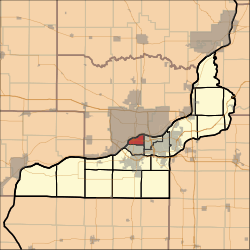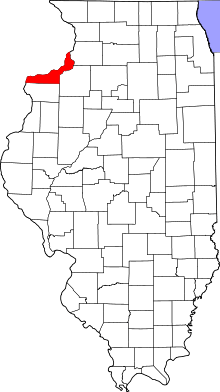Rock Island Township, Rock Island County, Illinois
Rock Island Township is located in Rock Island County, Illinois. As of the 2010 census, its population was 17,776 and it contained 7,271 housing units.[2]
Rock Island Township | |
|---|---|
Township | |
 Location in Rock Island County | |
 Rock Island County's location in Illinois | |
| Country | United States |
| State | Illinois |
| County | Rock Island |
| Established | November 4, 1856 |
| Government | |
| • Supervisor | Alan Carmen |
| Area | |
| • Total | 5.74 sq mi (14.9 km2) |
| • Land | 4.84 sq mi (12.5 km2) |
| • Water | 0.9 sq mi (2 km2) 15.68% |
| Population (2010) | |
| • Estimate (2016)[1] | 17,435 |
| • Density | 3,670/sq mi (1,420/km2) |
| Time zone | UTC-6 (CST) |
| • Summer (DST) | UTC-5 (CDT) |
| FIPS code | 17-161-65091 |
Geography
According to the 2010 census, the township has a total area of 5.74 square miles (14.9 km2), of which 4.84 square miles (12.5 km2) (or 84.32%) is land and 0.9 square miles (2.3 km2) (or 15.68%) is water.[2]
Demographics
| Historical population | |||
|---|---|---|---|
| Census | Pop. | %± | |
| Est. 2016 | 17,435 | [1] | |
| U.S. Decennial Census[3] | |||
gollark: But there are an infinitely large number of possible gods, and some do weirder things like "punish/reward entirely at random", "have no interest whatsoever in humanity", "punish people who believe in other gods", and all that, and Pascal's Wager just *ignores* those.
gollark: Pascal's Wager might work if the only options are "no god" or "one god, and it's the one you believe in, and they'll reward you if you believe and punish you otherwise".
gollark: Also, I should be specific, "a god and associated religious claims", not just "a god".
gollark: Pascal's Wager is really stupid.
gollark: > I’d rather just have faith and get on with my lifeThis seems like a bizarre attitude, since if you... don't actually have evidence for a god at all... it's really weird for that belief to affect your decisions.
References
- "Population and Housing Unit Estimates". Retrieved June 9, 2017.
- "Population, Housing Units, Area, and Density: 2010 - County -- County Subdivision and Place -- 2010 Census Summary File 1". United States Census. Archived from the original on 2020-02-12. Retrieved 2013-05-28.
- "Census of Population and Housing". Census.gov. Retrieved June 4, 2016.
This article is issued from Wikipedia. The text is licensed under Creative Commons - Attribution - Sharealike. Additional terms may apply for the media files.
